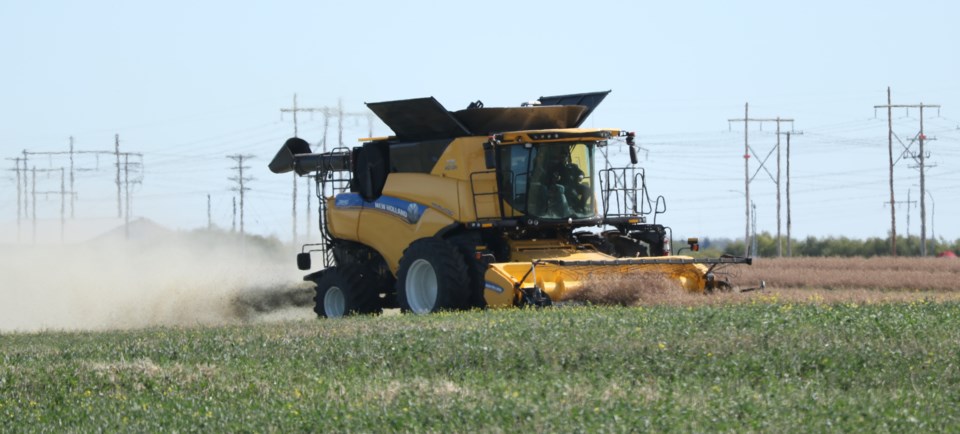For farmers, 2021 was a difficult year for the most part, but a lucky few found success in the face of an unprecedented drought, said Keystone Agriculture Producers director Charles Fossay.
“Prices are up, in many cases at highs that none of us have ever seen, [even those who have] been farming for 40 years or longer. Price wise, things look well for most producers.
“It’s very tight supplies and probably in many cases … because of the shortage of grain and the tight supplies, that’s why prices went up for many producers who had grain to sell.”
For most of the province, crop yields were below average, he said, and in some areas, the yields were almost at zero.
It is difficult to say how these yields will affect the everyday consumer, but it is possible they will begin to see higher food prices on some items because processors and food manufacturers are paying more for the raw product.
“It’s higher feed prices for hog producers, chicken producers, cattle producers. We’re also looking at higher wheat prices for the flour millers; high prices to the canola crushers that produce cooking oil,” Fossay said. “That eventually will all go down to consumers in some way or other. They may not end up paying the full price, but they will be picking up at least some of the increased costs.”
Farmers are also navigating the challenging economic landscape brought on by the historic drought over the summer, affecting overall crop yields.
“On my farm, I typically grow 45 bushels of canola and I’ll market that for $11 a bushel, so I’ll get $500 an acre for my canola,” Fossay said. “This year, my canola did 17 [bushels], and even though prices right now are around the $20 or $21 mark, I had pre-sold a lot of my canola for say, $15. I’m going to average out a slightly higher price than what I normally get, but based on the 17 bushels, I’m maybe only going to be getting two-thirds of what I would get in a normal year.”
Preparing for seeding in 2022, farmers are hoping to see additional moisture in the province to help rebuild crops.
The provincial government has said between 100 and 120 millimetres of snow will be needed to help recharge the water system in Manitoba and bump soil moisture up to normal levels.
“What we really need right now is a very white, snowy winter,” Fossay said. “We also need some very timely rains in the spring and throughout the summer that make sure we continue to recharge our soil moisture.”
He noted it will take many years to recharge moisture and build up reserves for the future.
In 2020, even though it was hot and dry, most farmers managed to get an average crop because they had good sub-soil moistures and rain fell during the summer, benefitting crop growth.
This year was a different story — the subsoil moisture had been depleted, and much-needed rains did not appear for the most part in May, June and July.
These dangerous factors were only exacerbated by multiple days of temperatures reaching 30 C or warmer, hurting the crops.
Farmers across the Prairies faced this problem in 2021, causing a huge impact around the country, Fossay said, especially because Alberta and Saskatchewan experienced even harsher weather compared to Manitoba.
Western Canada typically produces 21 tonnes of canola and exports about 12 million tonnes out of the country, fuelling trade, the economy and job growth.
This year saw only 12.5 million tonnes of canola produced, most of which will be processed in Canada and only a little bit will be exported.
“The hurt is very big,” Fossay said. “That means there’s less work for people at the elevators. There’s less work for the railway companies. There’s less work at the terminals. At some point, and it hasn’t happened yet, some of these businesses might be looking at laying off workers — that has an impact on everybody.”
He added these factors also make Canada a less dependable supplier of grain to international markets, which could lead to other countries buying wheat, grain and barley elsewhere.
Fossay said climatologists and others who examine weather patterns seem to indicate extreme weather may become the norm in the future.
“If you believe that global warming is occurring, [climatologists] say we’re going to see more extreme weather events — we’re going to see more droughts. They could be longer droughts, they could be severe droughts, but we’ll also see the opposite, something like we saw in B.C., where we could see more rainfall in some years and more localized flooding in some years.”
The volatile and unpredictable weather will force farmers and consumers to find ways to adjust to changing weather patterns and the higher risks they will be exposed to — this includes looking at changing production practices and finding how moisture can be preserved in the soil.
“Farming is always evolving. Farmers are always adapting to change. Whether it’s changes to the crops we grow, changes to how we market our grain or changes in weather patterns. We will try and adapt. Hopefully, we are successful, but if we’re not successful, we have to hope that government and consumers can help us through the bad years so that we’re still here when we have better times.”

